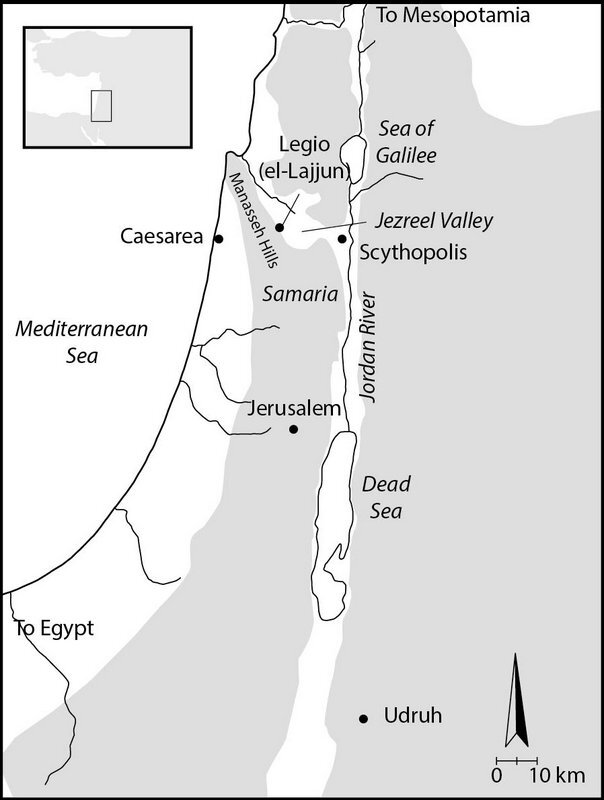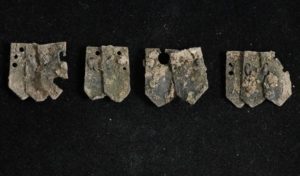
In the early First Century CE, Judaea became a province of Augustus’ expanding Roman Empire. By the late 60s, Jewish opposition to Roman administration had escalated to full-scale rebellion which resulted in the siege of Jerusalem and the destruction of its temple in 70 CE. Near the beginning of the Second Century CE, Legio VI Ferrata, the “Iron Legion”, was deployed to Judaea, joining Legio X Fretensis, which had been garrisoned in Jerusalem after the destruction of the temple. With the addition of a second legion, Judaea was incorporated into the province of Syria-Palaestina and upgraded to a proconsular province and new administrative policies were put in place to secure Rome’s hold on the region. The Sixth Legion remained in Palestine for nearly two centuries before being transferred to a new base in Udruh (Jordan), likely as a result of the extensive administrative and military reforms of the emperor Diocletian (284-305 CE).
________________________________________
_____________________________________
The exact location of the new legionary base (castra) of this legion, has been a matter of some debate by historians, but it is agreed that it was somewhere on the western edge of the Jezreel Valley in modern Israel near ancient Bronze and Iron Age Tel Megiddo[MJA1] (a UNESCO world heritage site[MJA2] ). Contemporary Latin and Greek sources place it in the vicinity of the Jewish village of Caparcotani/Kaperkotnei (Kefar ‘Othnay) and on the imperial road leading from the provincial capital of Caesarea Maritima on the coast to Scythopolis (Beth Shean) in the Jordan Valley. From this important location, the base of the Ferrata was well situated to control international imperial roads, as its predecessor Megiddo had done for nearly 3000 years. It also gave the legion direct access to the Galilee and inland valleys of northern Palestine – important centers of the local Jewish population at that time.
________________________________________
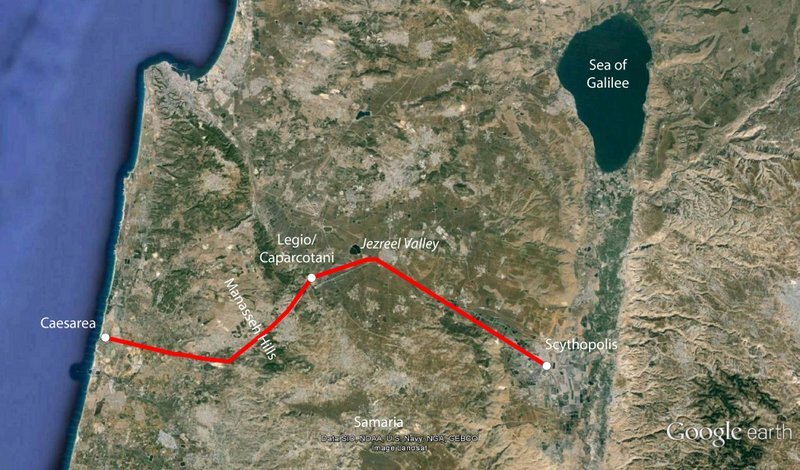 The imperial road (in red) from Caesarea to Scythopolis through Caparcotani.
The imperial road (in red) from Caesarea to Scythopolis through Caparcotani.
__________________________________________
The Roman-era historian Eusebius of Caesarea (260-340 CE) refers to a place called Legeon which he uses as a benchmark to describe the locations of various important Old and New Testament sites in the region. While a Roman-Byzantine polis called Maximianopolis was founded at the site in the 4th Century, the older name survived in the name of the Islamic to Ottoman period village and caravanserai of el-Lajjun. These names preserve the Latin, Legio, providing evidence for the location of the nearby legionary base. Thus, historical sources from the Roman and Byzantine periods point to three different settlements existing at Legio: the Jewish village of Kefar ‘Othnay (Caparcotna), a Roman legionary base (Legio), and a Byzantine polis of the 4th to 7th centuries CE (Maximianopolis).
While almost nothing is visible today, in the early 20th century, when Gottlieb Schumacher surveyed Megiddo and its environs, some remains of these once-great settlements were obvious on the surface. South of Tell Megiddo, Schumacher observed a Roman theater nestled in the foothills. To the east and south of the theater were scattered architectural ruins with Roman pottery, among which he found a brick or roof-tile stamped with “LEGVIF,” i.e. Legio VI Ferrata. In his day, the visible Roman-Ottoman ruins stretched far to the south including the hills of el-Manach and Daher ed-Dar, as far as the Wadi el-Lajjun, the ancient Nahal Qeni, through which the road to Caesarea and the coast passed the Manasseh hills. All told, Schumacher observed contiguous archaeological remains across more than 700 acres, representing the settlement history of the Megiddo/Legio area from ca. 3500 BCE to 1900 CE.
____________________________________
 Schumacher’s Survey Map (G. Schumacher, Tell el-Mutesellim [Leipzig, 1908] Pl. I).
Schumacher’s Survey Map (G. Schumacher, Tell el-Mutesellim [Leipzig, 1908] Pl. I).
_____________________________________
After Schumacher, little work was carried out at Legio until the 1990s. The most intensive survey of this area was conducted by Yotam Tepper (co-author here), who attempted to identify the exact locations of the legionary base, the village, and the polis. As part of his PhD research at Tel Aviv University, Tepper delineated discrete areas of Roman material culture remains, including coins and roof-tiles stamped with the name of the Sixth Legion, concentrated in and around the large agricultural field known as el-Manach.
_____________________________________
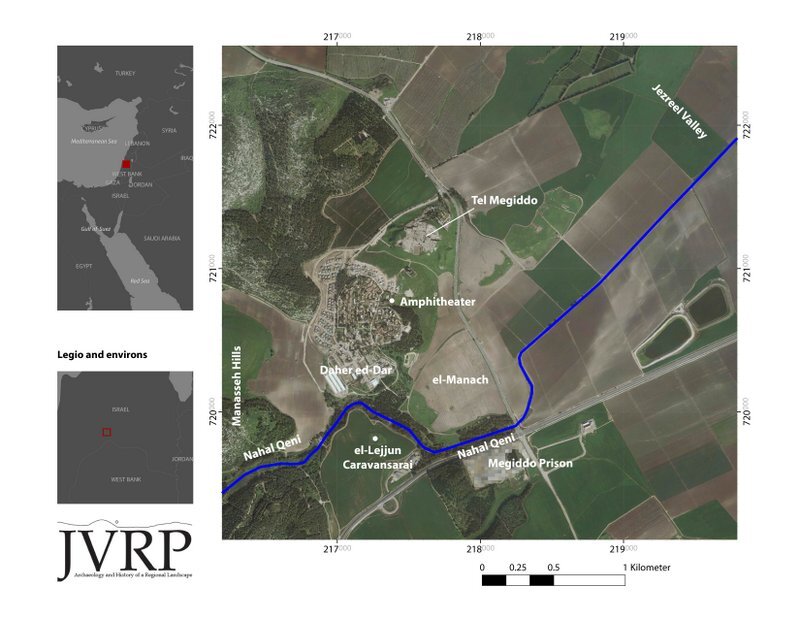 Map of the Megiddo/Legio Environs
Map of the Megiddo/Legio Environs
_______________________________________
While working nearby on behalf of the Israel Antiquities Authority in 2003-2005, Tepper also uncovered the now-famous 3rd– century Christian prayer hall [MJA4] [MJA5] at the Megiddo Prison just south of el-Manach, the mosaics of which bore dedicatory inscriptions to “God Jesus Christ,” including one sponsored by a centurion named Gaianus.[1] This find and others in the area of the prison strongly suggest that this area, just south of the base, was the location of Kefar ‘Othnay, the Jewish-Samaritan (and apparently Christian) village. Overall, Tepper concluded that there was compelling evidence pointing to the exact location of the castra of the Sixth Legion nearby in the field of el-Manach.[2]
In 2010 Tepper teamed up with the Jezreel Valley Regional Project[MJA6] (JVRP)[3] to begin archaeological investigations at el-Manach in search of architectural remains. In collaboration with Jessie Pincus and Tim de Smet (Texas A&M University), the JVRP conducted a Ground Penetrating Radar and Electromagnetic survey of this area. These technologies allowed the team to see beneath the surface of the fields and provided additional clues for the presence of significant architecture – in particular, the radar and electromagnetic anomalies suggested something long, linear, and wall-like along the northern depression.[4]
_____________________________________
 Working on the Ground Penetrating Radar study at el-Manach, looking northwards toward Tell Megiddo.
Working on the Ground Penetrating Radar study at el-Manach, looking northwards toward Tell Megiddo.
______________________________________
Additionally, aerial photographs, satellite imagery, and LiDAR data (airborne topographical laser scanning) acquired by the JVRP hinted at a large rectangular structure in the field just beneath the surface, at least 275m by 275m, bounded on the north and south by long depressions. The size and shape of the structure, and the surrounding depressions were consistent with Roman military architecture of the period.
______________________________________
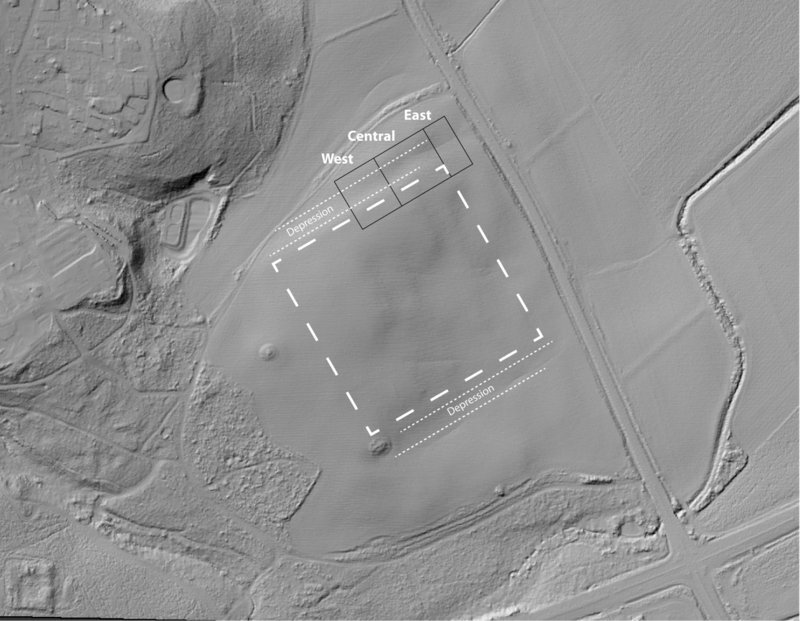 Shaded relief map of el-Manach based on 1-m resolution lidar data (data and imaging courtesy of the Jezreel Valley Regional Project). The GPR/EM survey grid appears in solid black lines. Tepper’s (2007) hypothesized minimum size location of the camp enclosure in long dashed white lines.
Shaded relief map of el-Manach based on 1-m resolution lidar data (data and imaging courtesy of the Jezreel Valley Regional Project). The GPR/EM survey grid appears in solid black lines. Tepper’s (2007) hypothesized minimum size location of the camp enclosure in long dashed white lines.
______________________________________
On the basis of Tepper’s archeological, historical, and geographical work, in combination with the remote sensing evidence, the JVRP spent two weeks during the summer of 2013 [MJA7] excavating a small part of the legionary base of Legio VI Ferrata.[5] Over the course of only ten excavation days, with the assistance of American and European students working side-by-side with members of local youth and community service groups[MJA8], the team exposed a north-south test trench of 125 m by 5 m that revealed clear evidence of this base [MJA9] and the Sixth Legion’s presence in it.
______________________________________
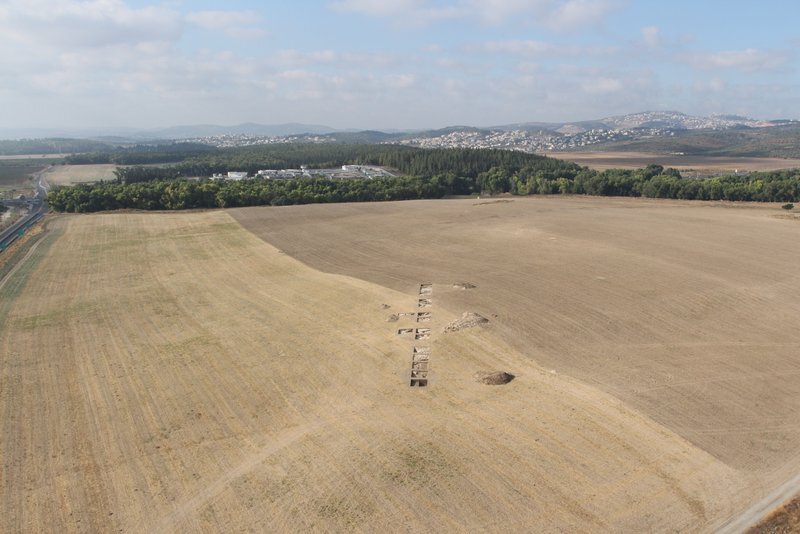 Aerial photograph of el-Manach and 2013 excavation area. Looking southward toward the Megiddo Prison.
Aerial photograph of el-Manach and 2013 excavation area. Looking southward toward the Megiddo Prison.
____________________________________
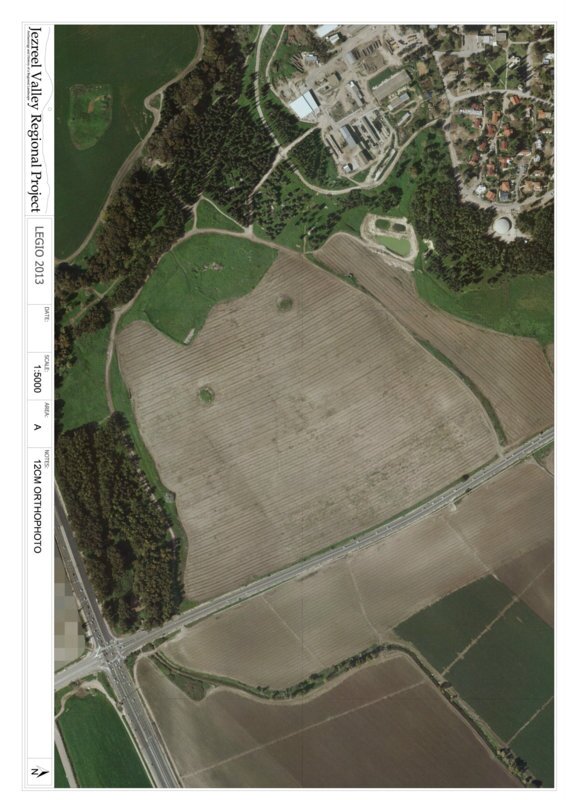 Planned 2013 excavation area at el-Manach.
Planned 2013 excavation area at el-Manach.
___________________________________
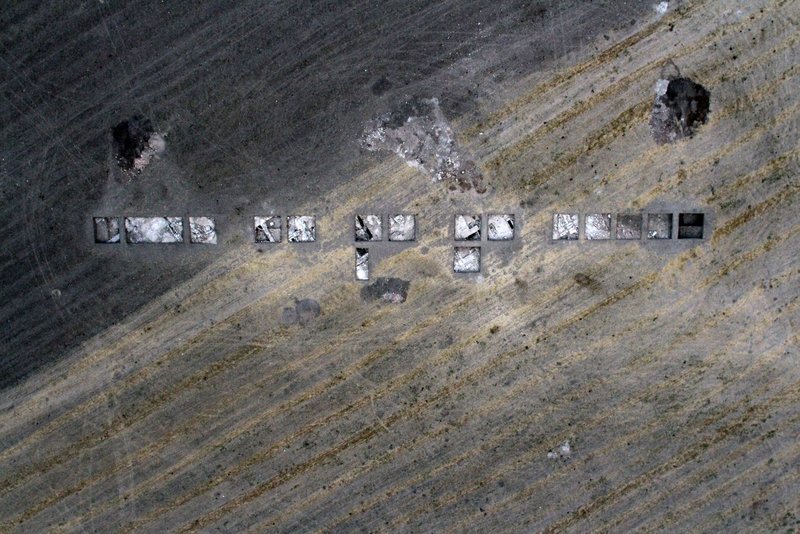 Aerial photograph of the 2013 excavations. North is to the right.
Aerial photograph of the 2013 excavations. North is to the right.
__________________________________
At the north end of this line, it became evident that the depressions seen in aerial photography were in fact part of a Roman legionary base’s typical defensive trenching earthworks, the fosse. Next to this 2m-deep ditch was the foundation of a great wall, nearly 6m wide, evidently the main circumvallation rampart of the base. In the remaining 100 m of the trench, extended within this outer wall, the team exposed a series of rooms likely belonging to one of the barracks of the camp. Much of the upper architectural remains had long been stripped away, but within the rooms were hundreds of ceramic roof tiles, some with the legion’s mark. Finds indicating the presence of the imperial army included a wide variety of local and foreign coins of the 2nd and 3rd centuries, fragments of scale armor, ceramic water pipes, and lead ingots – the Romans are known to have brought increased lead production to the eastern provinces. A surprise find on the last day of excavations was a stone table leg sculpted with the three-dimensional visage of a panther. Near the southern extent of the excavation, the putative barracks were bounded by a wide street carved in bedrock and flanked by drainage channels, probably one of the important roads connecting the barracks to the main street of the camp.
_______________________________________
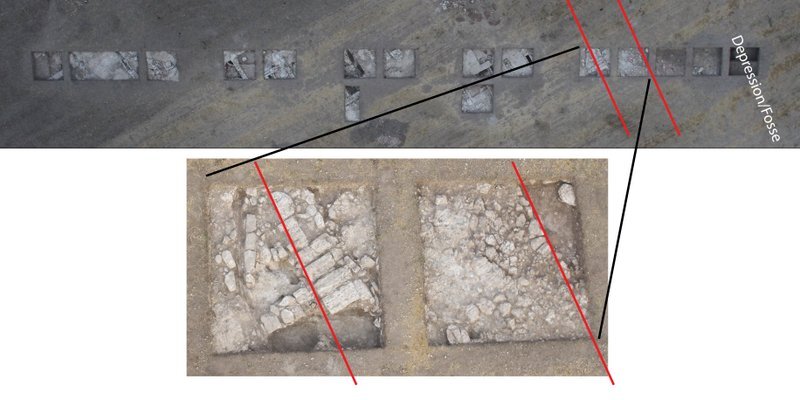 The 6 m wide base of the northern enclosure wall of the base. Squares to the right (north) of the wall descend into the fosse.
The 6 m wide base of the northern enclosure wall of the base. Squares to the right (north) of the wall descend into the fosse.
______________________________________
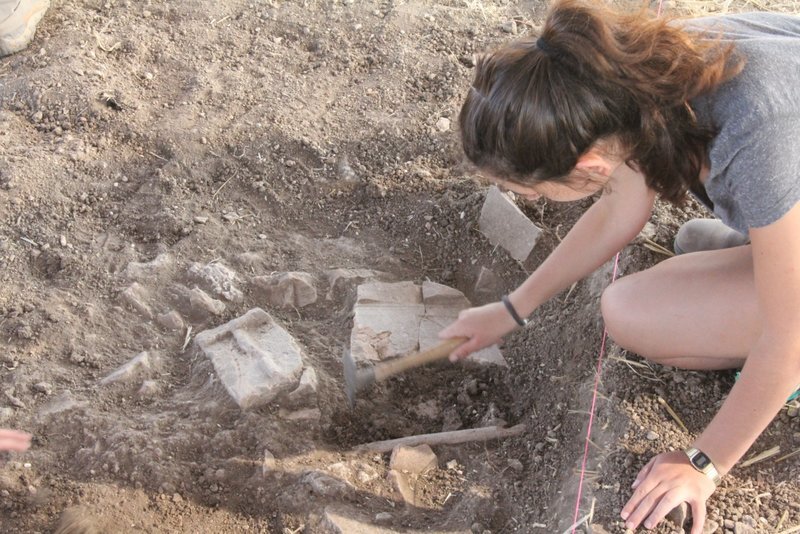 A volunteer excavates collapsed roof tiles from one of the barracks rooms.
A volunteer excavates collapsed roof tiles from one of the barracks rooms.
_______________________________________
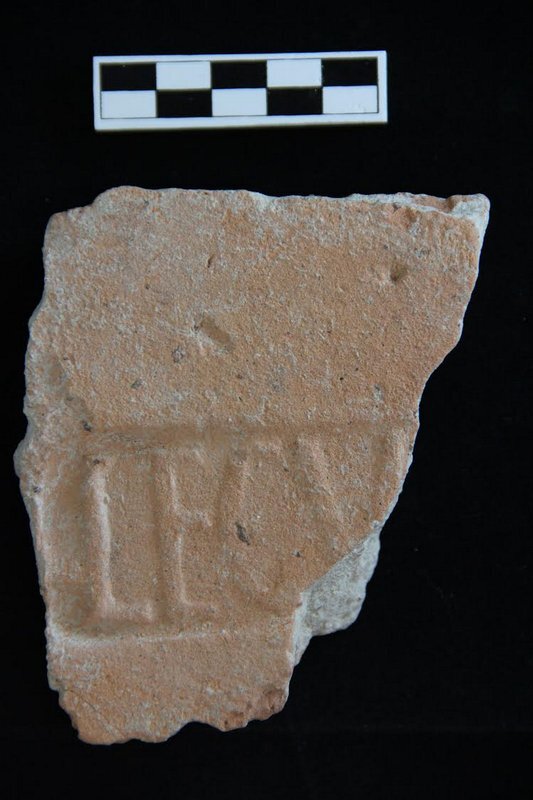 Roof tile stamped with LEG V[IFERR]
Roof tile stamped with LEG V[IFERR]
______________________________________
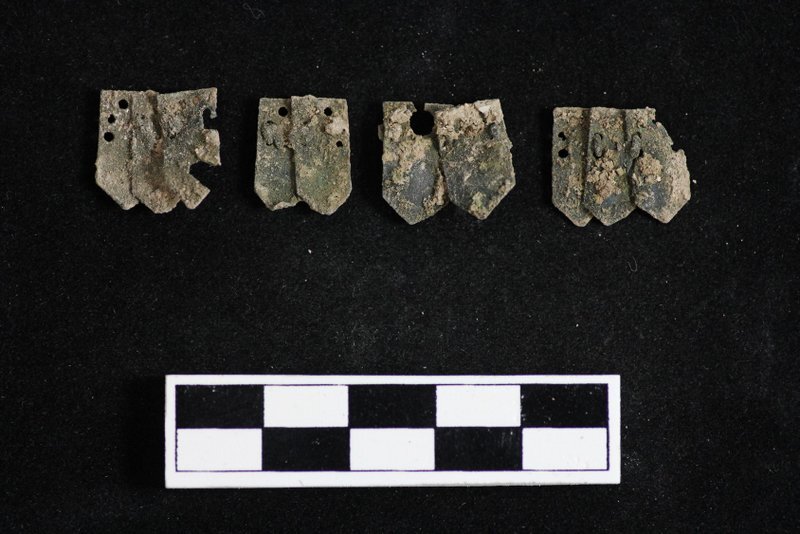 Roman armor scales found in the barracks
Roman armor scales found in the barracks
____________________________________
 Volunteers removing ceramic water supply pipes
Volunteers removing ceramic water supply pipes
_____________________________________
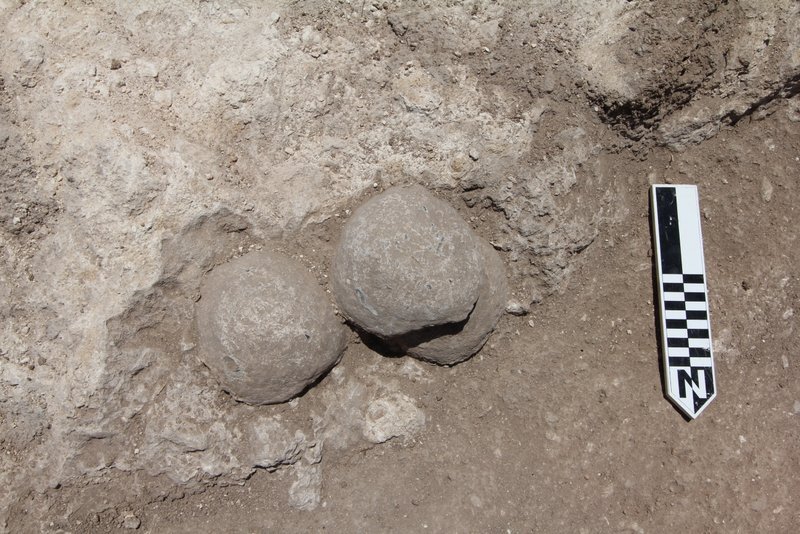 Three hemispherical lead ingots in situ
Three hemispherical lead ingots in situ
_______________________________________
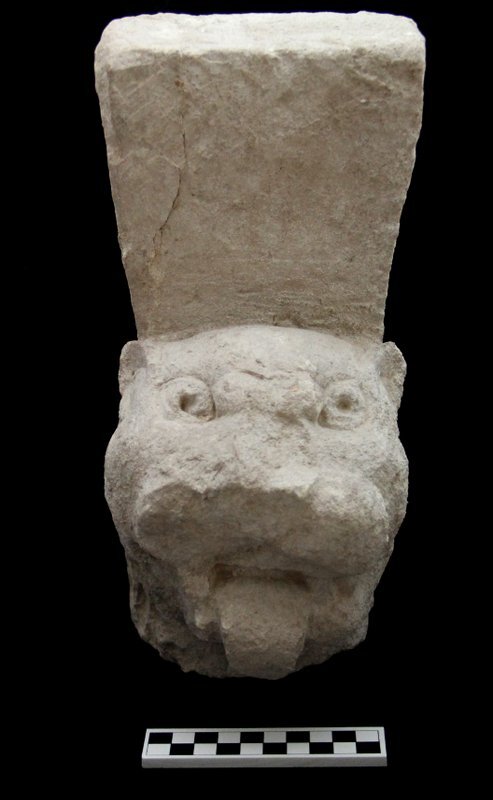 Sculpted limestone table leg with a feline head.
Sculpted limestone table leg with a feline head.
______________________________________
The data gathered so far in survey, research, and excavations shows a complex and unexpected settlement scenario at Legio. At its heart is a large legionary base of the Sixth Legion, perhaps accommodating the full legion of nearly 5000 soldiers from all over the empire. Nearby would have been a vicus, an ad hoc civilian settlement providing entertainment, commercial support, and other services for the men of the legion. At Kefar ‘Othnay, just south of the base, was a Jewish-Samaritan village in which there is evidence for an early Christian gathering place, dedicated in part by a Roman centurion.
The excavation of a Roman legionary base with clear ties to major political and cultural events in the formative years of Rabbinic Judaism and Christianity is exciting in itself, but Legio also provides an incredible new window on the Roman military occupation of the eastern provinces. No military headquarters of this type for this particular period have yet been excavated in the entire Eastern Empire. Not only will continued excavations at Legio reveal this important settlement in its own right, but its revelation may also be used as a proxy for the study of the Roman military’s occupation at Jerusalem and other parts of the empire before Diocletian’s reforms.
The JVRP’s 2013 excavation season, at both Legio and the nearby Bronze Age site of Tel Megiddo East[MJA10], has also served as a proving ground for a variety of new technologies that the team is developing for use in excavation.[6] These include photogrammetry[MJA11] for digitally mapping and planning, Structure from Motion for 3D imaging, Reflectance Transformation Imaging (RTI) for digital epigraphy, field X-Ray Florescence (XRF) studies[MJA12] for determining chemical composition of artifacts and sediments, and a highly anticipated archaeological and historical database system[MJA13], called Codifi, developed in cooperation with the Center for Digital Archaeology[MJA14] (CoDA) and Codifi, Inc.[MJA15] The technological star of our 2015 season promises to be our custom-built Unmanned Aerial Vehicle (UAV) for aerial imagery, remote sensing, and landscape modeling.
In June of 2015, the JVRP will return to Legio to continue exploration of the castra. The Legio excavation also serves as an archaeological field school, training as many as 50 undergraduate and graduate students annually, but participating in an archaeological dig is not just for college students. Through the JVRP’s volunteer program, numerous non-professionals participate in discovery every year, including local community groups, American and European retirees, and just about anyone else looking for a completely different kind of summer.
This year the volunteer program will include a 5-day preseason tour to sites in northern Israel (6-11 June 2015), taking participants off the beaten path, guided by archaeologists and historians specializing in these areas. The 4-week excavation will take place from 13 June to 10 July. All are welcome to join us[MJA16], or to follow our progress throughout the season on facebook and our website blog, to be a part of the revelation of the Roman army in Israel.
Speaking of revelation, the historical site of Legio is identified with biblical Har Megiddo, “the hill of Megiddo”, (the origin of the term Armageddon) the gathering place for the armies before the Last Battle in the New Testament (Rev. 16:16). What more apt location to initiate a campaign of liberation and salvation than from the site of the Sixth Legion? The JVRP’s project here is only in its opening stages, but this gathering point for the historical Roman army has already turned out to be quite an exciting place!
Find out more about the project and how to participate at the project website.
[1] Tepper Y. and Di Segni L. 2006. A Christian Prayer Hall of the 3rd Century CE at Kfar ‘Othnai (Legio). Excavations at the Megiddo Prison 2005. Israel Antiquities Authority; Jerusalem.
[2] Tepper Y. 2007. The Roman Legionary Camp at Legio, Israel: Results of an Archaeological Survey and Observations on the Roman Military Presence at the Site. In A.S. Lewin and P. Pellegrini (Eds.) The Late Roman Army in the Near East from Diocletian to the Arab Conquest (pp. 57-71). BAR International Series; Oxford.
[3] The Jezreel Valley Regional Project (JVRP) is a long-term, multi-disciplinary survey and excavation project investigating the history of human activity in the Jezreel Valley from the Paleolithic through the Ottoman period. It strives for a total history of the region using the tools and theoretical approaches of such disciplines as archaeology, anthropology, geography, history, ethnography, and the natural sciences, within an organizational framework provided by landscape archaeology. The project is directed by Matthew J. Adams (W.F. Albright Institute of Archaeological Research) with Jonathan David (Gettysburg College), Margaret Cohen (Penn State University), and Robert Homsher (Harvard University) as Assistant Directors.
[4] J. Pincus, T. DeSmet, Y. Tepper, and M.J. Adams, “Ground Penetrating Radar and Electromagnetic Archaeogeophysical Investigations at the Roman Legionary Camp at Legio, Israel,” Archaeological Prospection 20.3 (2013) 1-13. http://onlinelibrary.wiley.com/doi/10.1002/arp.1455/abstract
[5] The Legio excavations operate under the auspices of the JVRP, American Archaeology Abroad, the W.F. Albright Institute of Archaeological Research, and the University of Hawai’i with the cooperation of the Tel Aviv University Megiddo Expedition. The 2013 excavations were directed by Yotam Tepper (Tel Aviv University), Jonathan David (Gettysburg College), and Matthew J. Adams (W.F. Albright Institute of Archaeological Research).
[6] A. Prins, M.J. Adams, M. Ashley, R.S. Homsher, “Digital Archaeological Fieldwork and the Jezreel Valley Regional Project, Israel,” Near Eastern Archaeology 77:3 (2014) 196-201.
[MJA1]https://sites.google.com/site/megiddoexpedition/
[MJA2]http://whc.unesco.org/en/list/
http://www.archaeologie-online.de/magazin/nachrichten/bauingenieur-auf-den-spuren-der-antike-16834/
[MJA6]link to www.jezreelvalleyregionalproject.com
[MJA15]MJA TO ELABORATE LIKE THE NEA ARTICLE WITH FIGS
[MJA16]http://www.jezreelvalleyregionalproject.com/volunteer-2015.html
[MJA20]http://www.aiar.org/
[MJA21]www.americanarchaeologyabroad.org

